Moran M.J., Shapiro H.N. Fundamentals of Engineering Thermodynamics
Подождите немного. Документ загружается.


The entropy of an ideal gas depends on two properties, not on temperature alone as
for internal energy and enthalpy. Accordingly, for the mixture
S 5 S
1
1 S
2
1
. . .
1 S
j
5
a
j
i51
S
i
(12.25)
where S
i
is the entropy of component i evaluated at the mixture temperature T and
partial pressure p
i
(or at temperature T and total volume V).
Equation 12.25 can be written on a molar basis as
n
s
5 n
1
s
1
1 n
2
s
2
1
. . .
1 n
j
s
j
5
a
j
i51
n
i
s
i
(12.26)
where s is the entropy of the mixture per mole of mixture and s
i
is the entropy of
component i per mole of i. Dividing by the total number of moles of mixture, n, gives
an expression for the entropy of the mixture per mole of mixture
s 5
a
j
i51
y
i
s
i
(12.27)
In subsequent applications, the specific entropies s
i
of Eqs. 12.26 and 12.27 are evalu-
ated at the mixture temperature T and the partial pressure p
i
.
12.3.4 Working on a Mass Basis
In cases where it is convenient to work on a mass basis, the foregoing expressions are
written with the mass of the mixture, m, and the mass of component i in the mixture,
m
i
, replacing, respectively, the number of moles of mixture, n, and the number of moles
of component i, n
i
. Similarly, the mass fraction of component i, mf
i
, replaces the mole
fraction, y
i
. All specific internal energies, enthalpies, and entropies are evaluated on a
unit mass basis rather than on a per mole basis as above. To illustrate, Table 12.2
Property Relations on a Mass Basis for Binary Ideal Gas Mixtures
Notation: m
1
5 mass of gas 1, M
1
5 molecular weight of gas 1
m
2
5 mass of gas 2, M
2
5 molecular weight of gas 2
m 5 mixture mass 5 m
1
1 m
2
, mf
1
5 (m
1
/m), mf
2
5 (m
2
/m)
T 5 mixture temperature, p 5 mixture pressure, V 5 mixture volume
Equation of state:
p 5 m(
R/M)T/V (a)
where M 5 (y
1
M
1
1 y
2
M
2
) and the mole fractions y
1
and y
2
are given by
y
1
5 n
1
/(n
1
1 n
2
), y
2
5 n
2
/(n
1
1 n
2
) (b)
where n
1
5 m
1
/M
1
and n
2
5 m
2
/M
2
.
Partial pressures: p
1
5 y
1
p, p
2
5 y
2
p (c)
Properties on a mass basis:
Mixture enthalpy: H 5 m
1
h
1
(T ) 1 m
2
h
2
(T ) (d)
Mixture internal energy: U 5 m
1
u
1
(T ) 1 m
2
u
2
(T ) (e)
Mixture specific heats: c
p
5 (m
1
/m)c
p1
(T ) 1 (m
2
/m)c
p2
(T )
5 (mf
1
)c
p1
(T ) 1 (mf
2
)c
p2
(T ) (f)
c
y
5 (m
1
/m)c
y1
(T ) 1 (m
2
/m)c
y2
(T )
5 (mf
1
)c
y1
(T ) 1 (mf
2
)c
y2
(T ) (g)
Mixture entropy: S 5 m
1
s
1
(T, p
1
) 1 m
2
s
2
(T, p
2
) (h)
TABLE 12.2
12.3 Evaluating U, H, S, and Specific Heats 713
c12IdealGasMixtureandPsychrometr713 Page 713 6/29/10 11:54:06 AM user-s146c12IdealGasMixtureandPsychrometr713 Page 713 6/29/10 11:54:06 AM user-s146 /Users/user-s146/Desktop/Merry_X-Mas/New/Users/user-s146/Desktop/Merry_X-Mas/New
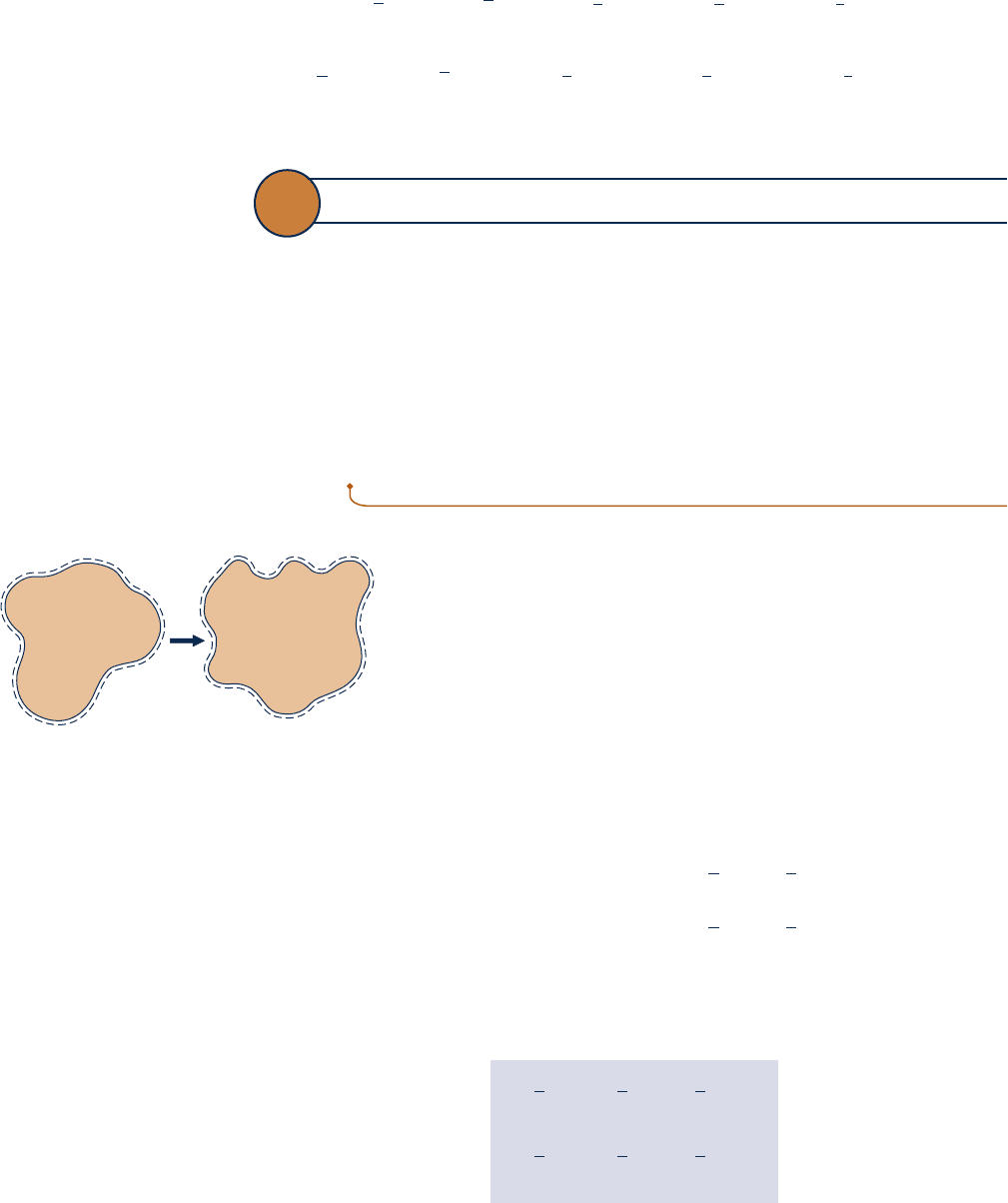
714 Chapter 12
Ideal Gas Mixture and Psychrometric Applications
provides property relations on a mass basis for binary mixtures. These relations are
applicable, in particular, to moist air, introduced in Sec. 12.5.
By using the molecular weight of the mixture or of component i, as appropriate,
data can be converted from a mass basis to a molar basis, or conversely, with relations
of the form
u 5 Mu,
h 5 Mh,
c
p
5 Mc
p
,
c
y
5 Mc
y
,
s 5 Ms (12.28)
for the mixture, and
u
i
5 M
i
u
i
,
h
i
5 M
i
h
i
,
c
p,i
5 M
i
c
p,i
,
c
y,i
5 M
i
c
y,i
,
s
i
5 M
i
s
i
(12.29)
for component i.
12.4 Analyzing Systems Involving Mixtures
To perform thermodynamic analyses of systems involving nonreacting ideal gas mixtures
requires no new fundamental principles. The conservation of mass and energy principles
and the second law of thermodynamics are applicable in the forms previously intro-
duced. The only new aspect is the proper evaluation of the required property data for
the mixtures involved. This is illustrated in the present section, which deals with two
classes of problems involving mixtures: In Sec. 12.4.1 the mixture is already formed, and
we study processes in which there is no change in composition. Section 12.4.2 considers
the formation of mixtures from individual components that are initially separate.
12.4.1 Mixture Processes at Constant Composition
In the present section we are concerned with the case of ideal gas
mixtures undergoing processes during which the composition remains
constant. The number of moles of each component present, and thus
the total number of moles of mixture, remain the same throughout the
process. This case is shown schematically in Fig. 12.2, which is labeled
with expressions for U, H, and S of a mixture at the initial and final
states of a process undergone by the mixture. In accordance with the
discussion of Sec. 12.3, the specific internal energies and enthalpies of
the components are evaluated at the temperature of the mixture. The
specific entropy of each component is evaluated at the mixture tem-
perature and the partial pressure of the component in the mixture.
The changes in the internal energy and enthalpy of the mixture
during the process are given, respectively, by
U
2
2 U
1
5
a
j
i51
n
i
3u
i
1T
2
22 u
i
1T
1
24
(12.30)
H
2
2 H
1
5
a
j
i51
n
i
3h
i
1T
2
22 h
i
1T
1
24
(12.31)
where T
1
and T
2
denote the temperature at the initial and final states. Dividing by
the number of moles of mixture, n, expressions for the change in internal energy and
enthalpy of the mixture per mole of mixture result
¢u 5
a
j
i51
y
i
3u
i
1T
2
22 u
i
1T
1
24
(12.32)
¢h 5
a
j
i51
y
i
3h
i
1T
2
22 h
i
1T
1
24
(12.33)
(n
1
, n
2
, …, n
j
)
at
T
1
, p
1
State 1 State 2
(n
1
, n
2
, …, n
j
)
at
T
2
, p
2
i
Σ
=
j
1
n
i
u
_
i
(T
1
)U
1
=
i
Σ
=
j
1
n
i
h
_
i
(T
1
)H
1
=
i
Σ
=
j
1
n
i
s
_
i
(T
1
, p
i1
)S
1
=
i
Σ
=
j
1
n
i
u
_
i
(T
2
)U
2
=
i
Σ
=
j
1
n
i
h
_
i
(T
2
)H
2
=
i
Σ
=
j
1
n
i
s
_
i
(T
2
, p
i2
)S
2
=
Fig. 12.2 Process of an ideal gas mixture.
c12IdealGasMixtureandPsychrometr714 Page 714 6/29/10 11:54:07 AM user-s146c12IdealGasMixtureandPsychrometr714 Page 714 6/29/10 11:54:07 AM user-s146 /Users/user-s146/Desktop/Merry_X-Mas/New/Users/user-s146/Desktop/Merry_X-Mas/New

Similarly, the change in entropy for the mixture is
S
2
2 S
1
5
a
j
i51
n
i
3s
i
1T
2
, p
i2
22 s
i
1T
1
, p
i1
24
(12.34)
where p
i1
and p
i2
denote, respectively, the initial and final partial pressures of com-
ponent i. Dividing by the total moles of mixture, Eq. 12.34 becomes
¢s 5
a
j
i51
y
i
3s
i
1T
2
, p
i2
22 s
i
1T
1
, p
i1
24
(12.35)
Companion expressions for Eqs. 12.30 through 12.35 on a mass basis also can be
written. This is left as an exercise.
The foregoing expressions giving the changes in internal energy, enthalpy, and
entropy of the mixture are written in terms of the respective property changes of the
components. Accordingly, different datums might be used to assign specific enthalpy
values to the various components because the datums would cancel when the com-
ponent enthalpy changes are calculated. Similar remarks apply to the cases of inter-
nal energy and entropy.
Using Ideal Gas Tables
For several common gases modeled as ideal gases, the quantities u
i
and h
i
appearing
in the foregoing expressions can be evaluated as functions of temperature only from
Tables A-22 and A-23. Table A-22 for air gives these quantities on a mass basis. Table
A-23 gives them on a molar basis.
The ideal gas tables also can be used to evaluate the entropy change. The change
in specific entropy of component i required by Eqs. 12.34 and 12.35 can be deter-
mined with Eq. 6.20b as
¢s
i
5 s8
i
1T
2
22 s8
i
1T
1
22 R ln
p
i2
p
i1
Since the mixture composition remains constant, the ratio of the partial pressures in
this expression is the same as the ratio of the mixture pressures, as can be shown by
using Eq. 12.12 to write
p
i2
p
i1
5
y
i
p
2
y
i
p
1
5
p
2
p
1
Accordingly, when the composition is constant, the change in the specific entropy of
component i is simply
¢
s
i
5 s8
i
1T
2
22 s8
i
1T
1
22 R ln
p
2
p
1
(12.36)
where p
1
and p
2
denote, respectively, the initial and final mixture pressures. The terms
s
8
i
of Eq. 12.36 can be obtained as functions of temperature for several common gases
from Table A-23. Table A-22 for air gives s8 versus temperature.
Assuming Constant Specific Heats
When the component specific heats c
y,i
and c
p,i
are taken as constants, the specific
internal energy, enthalpy, and entropy changes of the mixture and the components of
the mixture are given by
¢u 5 c
y
1T
2
2 T
1
2, ¢u
i
5 c
y,i
1T
2
2 T
1
2 (12.37)
¢h 5 c
p
1T
2
2 T
1
2, ¢h
i
5 c
p,i
1T
2
2 T
1
2 (12.38)
¢
s 5 c
p
ln
T
2
T
1
2 R ln
p
2
p
1
,
¢s
i
5 c
p,i
ln
T
2
T
1
2 R ln
p
2
p
1
(12.39)
TAKE NOTE...
When mixture composition
remains constant, a ratio
of partial pressures, p
i2
/p
i1
,
equals the ratio of mixture
pressures, p
2
/p
1
.
12.4 Analyzing Systems Involving Mixtures 715
c12IdealGasMixtureandPsychrometr715 Page 715 6/29/10 11:54:10 AM user-s146c12IdealGasMixtureandPsychrometr715 Page 715 6/29/10 11:54:10 AM user-s146 /Users/user-s146/Desktop/Merry_X-Mas/New/Users/user-s146/Desktop/Merry_X-Mas/New

716 Chapter 12 Ideal Gas Mixture and Psychrometric Applications
where the mixture specific heats c
y
and c
p
are evaluated from Eqs. 12.23 and 12.24,
respectively, using data from Tables A-20 or the literature, as required.
The expression for ¢u can be obtained formally by substituting the above
expression for ¢u
i
into Eq. 12.32 and using Eq. 12.23 to simplify the result. Simi-
larly, the expressions for ¢
h
and ¢s can be obtained by inserting ¢h
i
and ¢s
i
into
Eqs. 12.33 and 12.35, respectively, and using Eq. 12.24 to simplify. In the equations
for entropy change, the ratio of mixture pressures replaces the ratio of partial
pressures as discussed above. Similar expressions can be written for the mixture
specific internal energy, enthalpy, and entropy changes on a mass basis. This is left
as an exercise.
Using Computer Software
The changes in internal energy, enthalpy, and entropy required in Eqs. 12.32, 12.33,
and 12.35, respectively, also can be evaluated using computer software. Interactive
Thermodynamics: IT provides data for a large number of gases modeled as ideal
gases, and its use is illustrated in Example 12.4 below.
The next example illustrates the use of ideal gas mixture relations for analyzing a
compression process.
Analyzing an Ideal Gas Mixture Undergoing Compression
c c c c EXAMPLE 12.3 c
A mixture of 0.3 lb of carbon dioxide and 0.2 lb of nitrogen is compressed from p
1
5 1 atm, T
1
5 540°R to p
2
5
3 atm in a polytropic process for which n 5 1.25. Determine (a) the final temperature, in 8R, (b) the work, in Btu,
(c) the heat transfer, in Btu, (d) the change in entropy of the mixture, in Btu/°R.
SOLUTION
Known:
A mixture of 0.3 lb of CO
2
and 0.2 lb of N
2
is compressed in a polytropic process for which n 5 1.25.
At the initial state, p
1
5 1 atm, T
1
5 540°R. At the final state, p
2
5 3 atm.
Find: Determine the final temperature, in °R, the work, in Btu, the heat transfer, in Btu, and the entropy change
of the mixture in, Btu/°R.
Schematic and Given Data:
Fig. E12.3
p
v
States of the
mixture
n = 1.25
1
2
0.3 lb CO
2
0.2 lb N
2
Boundary
p
1
= 1 atm, T
1
= 540°R,
p
2
= 3 atm
Engineering Model:
1.
As shown in the accompanying figure,
the system is the mixture of CO
2
and N
2
.
The mixture composition remains
constant during the compression.
2. The Dalton model applies: Each mix-
ture component behaves as if it were
an ideal gas occupying the entire sys-
tem volume at the mixture temperature.
The overall mixture acts as an ideal gas.
3. The compression process is a poly-
tropic process for which n 5 1.25.
4. The changes in kinetic and potential
energy between the initial and final
states can be ignored.
c12IdealGasMixtureandPsychrometr716 Page 716 7/23/10 7:05:28 PM user-s146c12IdealGasMixtureandPsychrometr716 Page 716 7/23/10 7:05:28 PM user-s146 /Users/user-s146/Desktop/Merry_X-Mas/New/Users/user-s146/Desktop/Merry_X-Mas/New

Analysis:
(a)
For an ideal gas, the temperatures and pressures at the end states of a polytropic process are related by
Eq. 3.56
T
2
5 T
1
a
p
2
p
1
b
1n212
/
n
Inserting values
T
2
5 540a
3
1
b
0.2
5 6738R
(b) The work for the compression process is given by
W 5
#
2
1
p dV
Introducing pV
n
5 constant and performing the integration
W 5
p
2
V
2
2 p
1
V
1
1 2 n
With the ideal gas equation of state, this reduces to
W 5
m1R
/
M21T
2
2 T
1
2
1 2 n
The mass of the mixture is m 5 0.3 1 0.2 5 0.5 lb. The apparent molecular weight of the mixture can be
calculated using M 5 m/n, where n is the total number of moles of mixture. With Eq. 12.1, the numbers of moles
of CO
2
and N
2
are, respectively
n
CO
2
5
0.3
44
5 0.0068 lbmol,
n
N
2
5
0.2
28
5 0.0071 lbmol
The total number of moles of mixture is then n 5 0.0139 lbmol. The apparent molecular weight of the mixture
is M 5 0.5/0.0139 5 35.97.
Calculating the work
W 5
10.5 lb2a
1545 ft ? lbf
35.97 lb ? 8R
b16738R 2 5408R2
1 2 1.25
`
1 Btu
778 ft ? lbf
`
5214
.69
B
tu
where the minus sign indicates that work is done on the mixture, as expected.
(c) With assumption 4, the closed system energy balance can be placed in the form
Q 5 ¢U 1 W
where DU is the change in internal energy of the mixture.
The change in internal energy of the mixture equals the sum of the internal energy changes of the components.
With Eq. 12.30
➊ ¢U 5 n
CO
2
3u
CO
2
1T
2
22 u
CO
2
1T
1
241 n
N
2
3u
N
2
1T
2
22 u
N
2
1T
1
24
This form is convenient because Table A-23E gives internal energy values for N
2
and CO
2
, respectively, on a
molar basis. With values from this table
¢U 5 10.0068213954 2 298421 10.0071213340 2 26782
5 11.3 Btu
Inserting values for DU and W into the expression for Q
Q 5111.3 2 14.69 523.39 Btu
where the minus sign signifies a heat transfer from the system.
12.4 Analyzing Systems Involving Mixtures 717
c12IdealGasMixtureandPsychrometr717 Page 717 6/29/10 11:54:15 AM user-s146c12IdealGasMixtureandPsychrometr717 Page 717 6/29/10 11:54:15 AM user-s146 /Users/user-s146/Desktop/Merry_X-Mas/New/Users/user-s146/Desktop/Merry_X-Mas/New
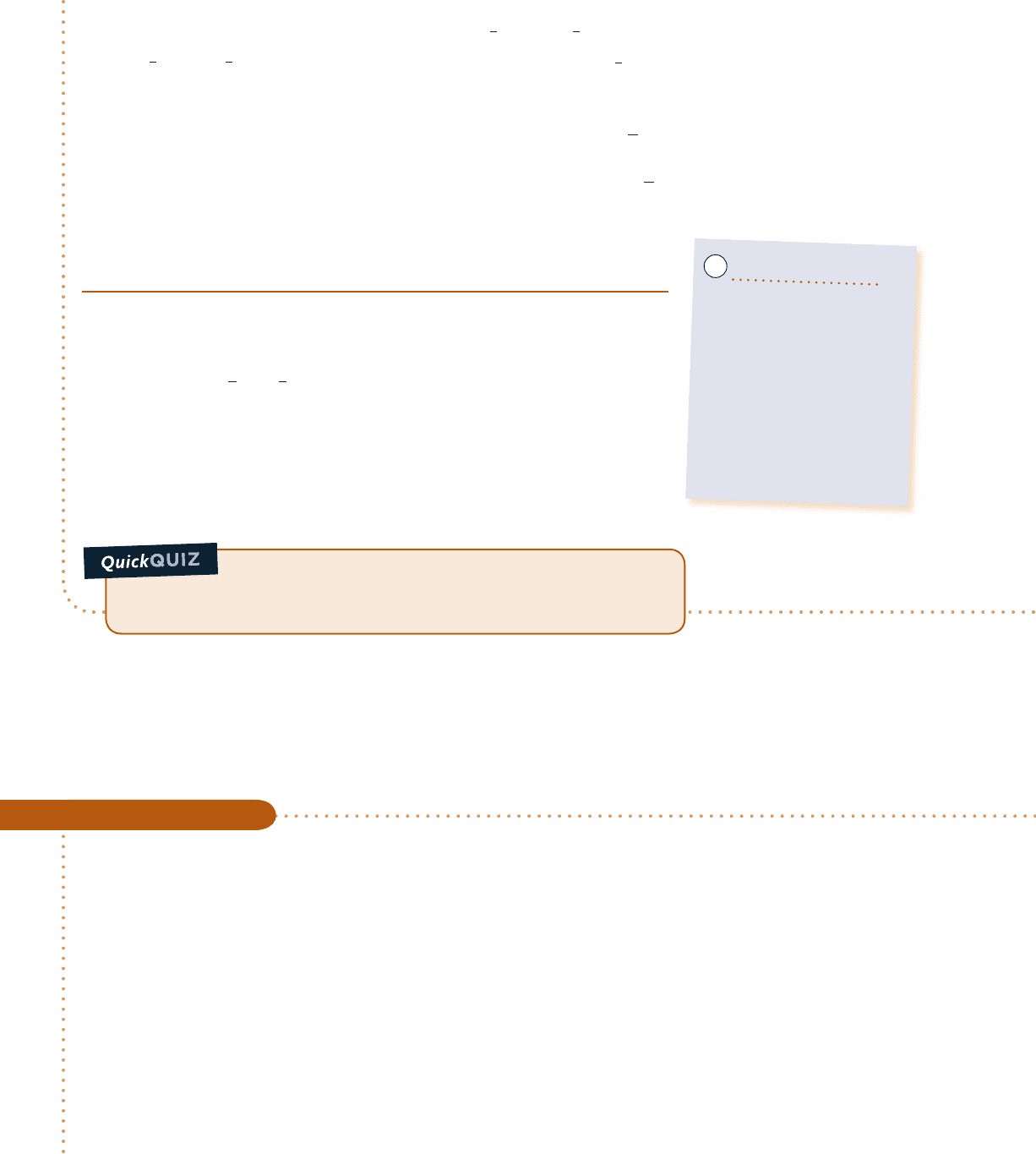
718 Chapter 12 Ideal Gas Mixture and Psychrometric Applications
The next example illustrates the application of ideal gas mixture principles for the
analysis of a mixture expanding isentropically through a nozzle. The solution features
the use of table data and IT as an alternative.
(d) The change in entropy of the mixture equals the sum of the entropy changes of the components. With Eq. 12.34
¢S 5 n
CO
2
¢s
CO
2
1 n
N
2
¢s
N
2
where ¢s
N
2
and ¢s
CO
2
are evaluated using Eq. 12.36 and values of s8 for N
2
and CO
2
from Table A-23E.
That is
¢S 5 0.0068a53.123 2 51.082 2 1.986 ln
3
1
b
1 0.0071a47.313 2 45.781 2 1.986 ln
3
1
b
520.0056 Btu
/
8R
Entropy decreases in the process because entropy is transferred from the system
accompanying heat transfer.
➊ In view of the relatively small temperature change, the changes in the inter-
nal energy and entropy of the mixture can be evaluated alternatively using
the constant specific heat relations, Eqs. 12.37 and 12.39, respectively. In
these equations, c
y
and c
p
are specific heats for the mixture determined using
Eqs. 12.23 and 12.24 together with appropriate specific heat values for the
components chosen from Table A-20E.
➋ Since the composition remains constant, the ratio of partial pressures equals
the ratio of mixture pressures, so Eq. 12.36 can be used to evaluate the
component specific entropy changes required here.
Recalling that polytropic processes are internally reversible,
determine for the system the amount of entropy transfer accompanying
heat transfer, in Btu/°R. Ans. 20.0056 Btu/°R.
➋
Considering an Ideal Gas Mixture Expanding Isentropically Through a Nozzle
c c c c EXAMPLE 12.4 c
A gas mixture consisting of CO
2
and O
2
with mole fractions 0.8 and 0.2, respectively, expands isentropically and
at steady state through a nozzle from 700 K, 5 atm, 3 m/s to an exit pressure of 1 atm. Determine (a) the tem-
perature at the nozzle exit, in K, (b) the entropy changes of the CO
2
and O
2
from inlet to exit, in kJ/kmol ? K,
(c) the exit velocity, in m/s.
SOLUTION
Known:
A gas mixture consisting of CO
2
and O
2
in specified proportions expands isentropically through a nozzle
from specified inlet conditions to a given exit pressure.
Find: Determine the temperature at the nozzle exit, in K, the entropy changes of the CO
2
and O
2
from inlet to
exit, in kJ/kmol ? K, and the exit velocity, in m/s.
Ability to…
❑
analyze a polytropic pro-
cess of a closed system for
a mixture of ideal gases.
❑
apply ideal gas mixture
principles.
❑
determine changes in inter-
nal energy and entropy for
ideal gas mixtures using
tabular data.
✓
Skills Developed
c12IdealGasMixtureandPsychrometr718 Page 718 6/29/10 11:54:18 AM user-s146c12IdealGasMixtureandPsychrometr718 Page 718 6/29/10 11:54:18 AM user-s146 /Users/user-s146/Desktop/Merry_X-Mas/New/Users/user-s146/Desktop/Merry_X-Mas/New
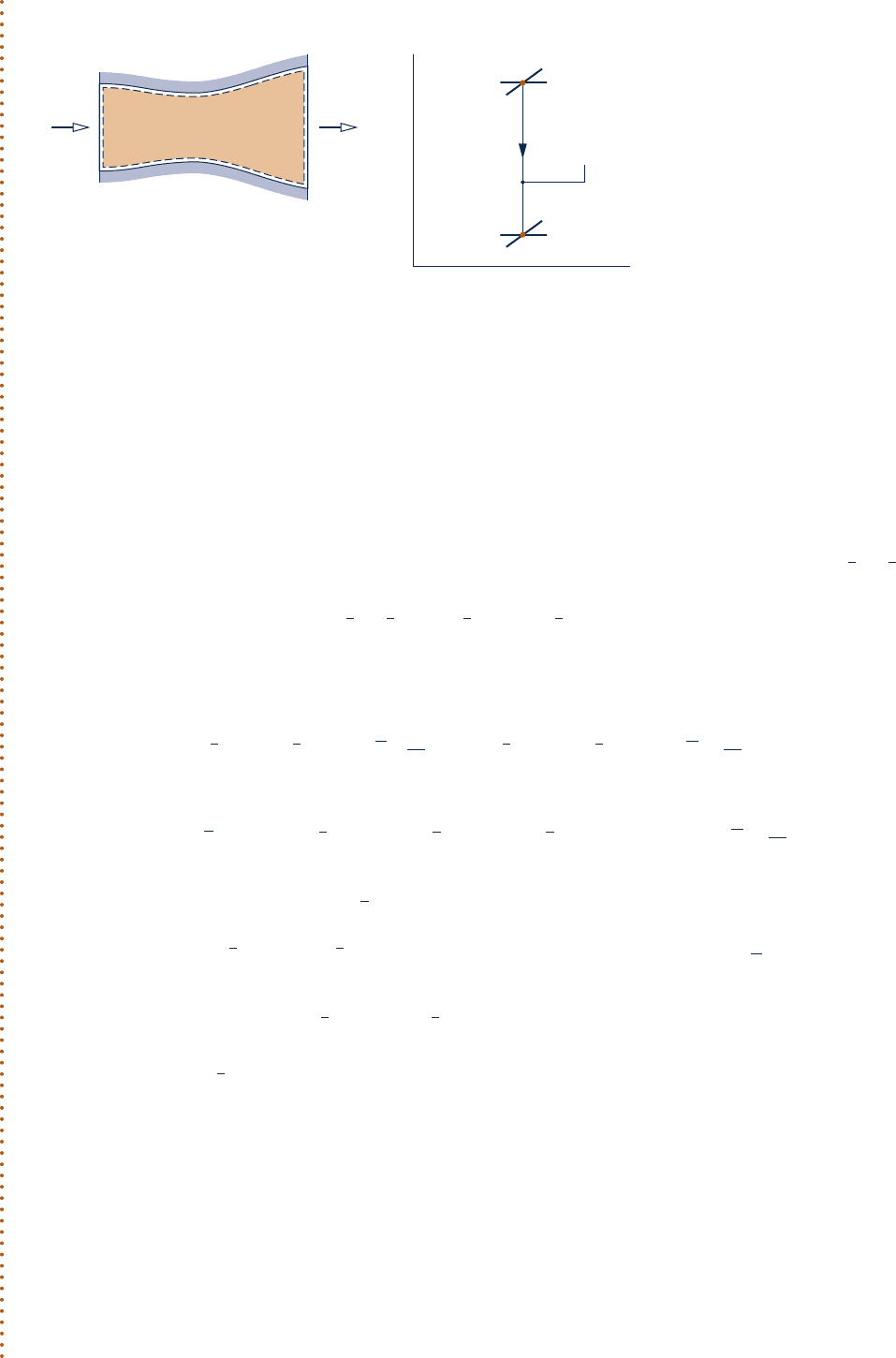
Fig. E12.4
T
s
T
1
= 700 K
2
1
V
1
p
1
T
1
= 3 m/s
= 5 atm
= 700 K
p
2
=
1 atm
1
2
p
1
= 5 atm
T
2
= ?
p
2
= 1 atm
States of the mixture
Schematic and Given Data:
Engineering Model:
1.
The control volume shown by the dashed line on the accompanying figure operates at steady state.
2. The mixture composition remains constant as the mixture expands isentropically through the nozzle.
3. The Dalton model applies: The overall mixture and each mixture component act as ideal gases. The state
of each component is defined by the temperature and the partial pressure of the component.
4. The change in potential energy between inlet and exit can be ignored.
Analysis:
(a)
The temperature at the exit can be determined using the fact that the expansion occurs isentropically: s
2
2 s
1
5 0.
As there is no change in the specific entropy of the mixture between inlet and exit, Eq. 12.35 can be used to write
s
2
2 s
1
5 y
O
2
¢s
O
2
1 y
CO
2
¢s
CO
2
5 0 (a)
Since composition remains constant, the ratio of partial pressures equals the ratio of mixture pressures. Accord-
ingly, the change in specific entropy of each component can be determined using Eq. 12.36. Equation (a) then
becomes
y
O
2
cs 8
O
2
1T
2
22 s8
O
2
1T
1
22 R ln
p
2
p
1
d1 y
CO
2
cs8
CO
2
1T
2
22 s8
CO
2
1T
1
22 R ln
p
2
p
1
d5 0
On rearrangement
y
O
2
s
8
O
2
1T
2
21 y
CO
2
s8
CO
2
1T
2
25 y
O
2
s8
O
2
1T
1
21 y
CO
2
s8
CO
2
1T
1
21 1y
O
2
1 y
CO
2
2R ln
p
2
p
1
The sum of mole fractions equals unity, so the coefficient of the last term on the right side is
1
y
O
2
1 y
CO
2
2
5 1.
Introducing given data, and values of s8 for O
2
and CO
2
at T
1
5 700 K from Table A-23
0.2s8
O
2
1T
2
21 0.8s8
CO
2
1T
2
25 0.21231.35821 0.81250.66321 8.314 ln
1
5
or
0.2s8
O
2
1T
2
21 0.8s8
CO
2
1T
2
25 233.42 kJ
/
kmol ? K
To determine the temperature T
2
requires an iterative approach with the above equation: A final temperature
T
2
is assumed, and the s8 values for O
2
and CO
2
are found from Table A-23. If these two values do not satisfy
the equation, another temperature is assumed. The procedure continues until the desired agreement is attained.
In the present case
at T 5 510 K:
0.21221.20621 0.81235.70025 232.80
at T 5 520 K:
0.21221.81221 0.81236.57525 233.62
Linear interpolation between these values gives T
2
5 517.6 K.
12.4 Analyzing Systems Involving Mixtures 719
c12IdealGasMixtureandPsychrometr719 Page 719 6/29/10 11:54:19 AM user-s146c12IdealGasMixtureandPsychrometr719 Page 719 6/29/10 11:54:19 AM user-s146 /Users/user-s146/Desktop/Merry_X-Mas/New/Users/user-s146/Desktop/Merry_X-Mas/New

720 Chapter 12 Ideal Gas Mixture and Psychrometric Applications
Alternative Solution:
Alternatively, the following IT program can be used to evaluate T
2
without resorting to iteration with table data.
In the program, yO2 denotes the mole fraction of O
2
, p1_O2 denotes the partial pressure of O
2
at state 1, s1_O2
denotes the entropy per mole of O
2
at state 1, and so on.
T1 5 700 // K
p1 5 5 // bar
p2 5 1 // bar
yO2 5 0.2
yCO2 5 0.8
p1_O2 5 yO2 * p1
p1_CO2 5 yCO2 * p1
p2_O2 5 yO2 * p2
p2_CO2 5 yCO2 * p2
s1_O2 5 s_TP (“O2”,T1,p1_O2)
s1_CO2 5 s_TP (“CO2”,T1,p1_CO2)
s2_O2 5 s_TP (“O2”,T2,p2_O2)
s2_CO2 5 s_TP (“CO2”,T2,p2_CO2)
// When expressed in terms of these quantities, Eq. (a) takes the form
yO2 * (s2_O2 2 s1_O2) 1 yCO2 * (s2_CO2 2 s1_CO2) 5 0
Using the Solve button, the result is T
2
5 517.6 K, which agrees with the value obtained using table data. Note that
IT provides the value of specific entropy for each component directly and does not return s8 of the ideal gas tables.
➊ (b) The change in the specific entropy for each of the components can be determined using Eq. 12.36. For O
2
¢s
O
2
5 s8
O
2
1T
2
22 s8
O
2
1T
1
22 R ln
p
2
p
1
Inserting s8 values for O
2
from Table A-23 at T
1
5 700 K and T
2
5 517.6 K
¢s
O
2
5 221.667 2 231.358 2 8.314 ln10.225 3.69 kJ
/
kmol ? K
Similarly, with CO
2
data from Table A-23
¢s
CO
2
5 s8
CO
2
1T
2
22 s8
CO
2
1T
1
22 R ln
p
2
p
1
5 236.365 2 250.663 2 8.314 ln10.22
➋ 520.92 kJ
/
kmol ? K
(c) Reducing the energy rate balance for the one-inlet, one-exit control volume at steady state
0 5 h
1
2 h
2
1
V
2
1
2 V
2
2
2
where h
1
and h
2
are the enthalpy of the mixture, per unit mass of mixture, at the inlet and exit, respectively.
Solving for V
2
V
2
5 2V
2
1
1 21h
1
2 h
2
2
The term (h
1
2 h
2
) in the expression for V
2
can be evaluated as
h
1
2 h
2
5
h
1
2 h
2
M
5
1
M
3y
O
2
1h
1
2 h
2
2
O
2
1 y
CO
2
1h
1
2 h
2
2
CO
2
4
where M is the apparent molecular weight of mixture, and the molar specific enthalpies of O
2
and CO
2
are from
Table A-23. With Eq. 12.9, the apparent molecular weight of the mixture is
M 5 0.814421 0.213225 41.6 kg
/
kmol
Then, with enthalpy values at T
1
5 700 K and T
2
5 517.6 K from Table A-23
h
1
2 h
2
5
1
41.6
30.2121,184 2 15,32021 0.8127,125 2 18,46824
5 194.7 kJ
/
kg
c12IdealGasMixtureandPsychrometr720 Page 720 6/29/10 11:54:24 AM user-s146c12IdealGasMixtureandPsychrometr720 Page 720 6/29/10 11:54:24 AM user-s146 /Users/user-s146/Desktop/Merry_X-Mas/New/Users/user-s146/Desktop/Merry_X-Mas/New
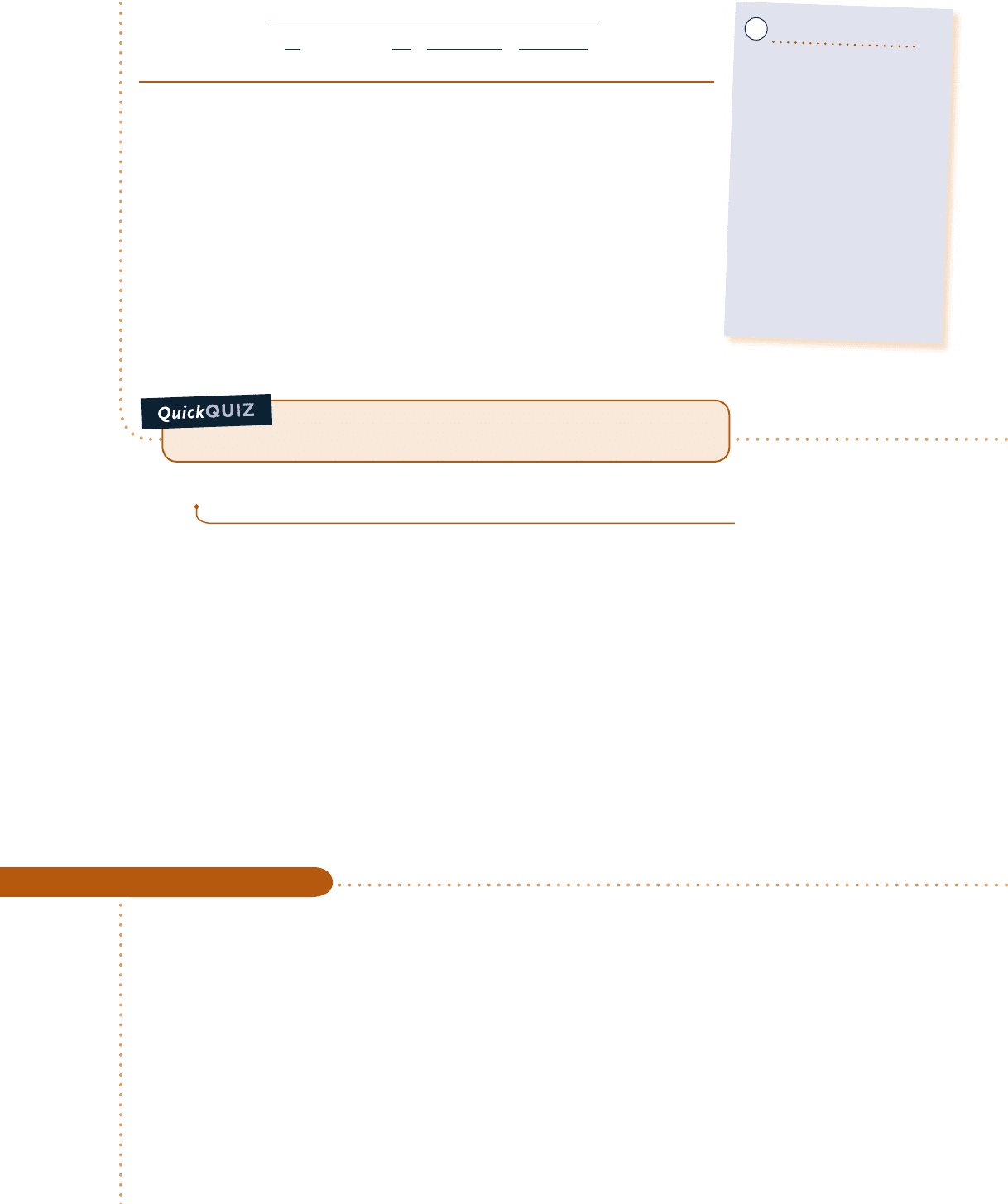
Finally,
➌ V
2
5
B
a3
m
s
b
2
1 2a194.7
kJ
kg
b`
1 kg ? m
/
s
2
1 N
``
10
3
N ? m
1 kJ
`5 624 m
/
s
➊ Parts (b) and (c) can be solved alternatively using IT. These parts also can
be solved using a constant c
p
together with Eqs. 12.38 and 12.39. Inspection
of Table A-20 shows that the specific heats of CO
2
and O
2
increase only
slightly with temperature over the interval from 518 to 700 K, and so suit-
able constant values of c
p
for the components and the overall mixture can
be readily determined. These alternative solutions are left as exercises.
➋ Each component experiences an entropy change as it passes from inlet to
exit. The increase in entropy of the oxygen and the decrease in entropy of
the carbon dioxide are due to entropy transfer accompanying heat transfer
from the CO
2
to the O
2
as they expand through the nozzle. However, as
indicated by Eq. (a), there is no change in the entropy of the mixture as it
expands through the nozzle.
➌ Note the use of unit conversion factors in the calculation of V
2
.
Ability to…
❑
analyze the isentropic expan-
sion of an ideal gas mixture
flowing through a nozzle.
❑
apply ideal gas mixture
principles together with
mass and energy balances
to calculate the exit veloc-
ity of a nozzle.
❑
determine the exit tem-
perature for a given inlet
state and a given exit pres-
sure using tabular data and
alternatively using IT.
✓Skills Developed
12.4.2
Mixing of Ideal Gases
Thus far, we have considered only mixtures that have already been formed. Now let
us take up cases where ideal gas mixtures are formed by mixing gases that are initially
separate. Such mixing is irreversible because the mixture forms spontaneously, and a
work input from the surroundings would be required to separate the gases and return
them to their respective initial states. In this section, the irreversibility of mixing is
demonstrated through calculations of the entropy production.
Three factors contribute to the production of entropy in mixing processes:
The gases are initially at different temperatures.
The gases are initially at different pressures.
The gases are distinguishable from one another.
Entropy is produced when any of these factors is present during a mixing process.
This is illustrated in the next example, where different gases, initially at different
temperatures and pressures, are mixed.
1.
2.
3.
Investigating Adiabatic Mixing of Gases at Constant Total Volume
c c c c EXAMPLE 12.5 c
Two rigid, insulated tanks are interconnected by a valve. Initially 0.79 lbmol of nitrogen at 2 atm and 4608R fills
one tank. The other tank contains 0.21 lbmol of oxygen at 1 atm and 5408R. The valve is opened and the gases are
allowed to mix until a final equilibrium state is attained. During this process, there are no heat or work interactions
between the tank contents and the surroundings. Determine (a) the final temperature of the mixture, in 8R, (b) the
final pressure of the mixture, in atm, (c) the amount of entropy produced in the mixing process, in Btu/8R.
SOLUTION
Known:
Nitrogen and oxygen, initially separate at different temperatures and pressures, are allowed to mix with-
out heat or work interactions with the surroundings until a final equilibrium state is attained.
What would be the exit velocity, in m/s, if the isentropic nozzle
efficiency were 90%? Ans. 592 m/s.
12.4 Analyzing Systems Involving Mixtures 721
c12IdealGasMixtureandPsychrometr721 Page 721 6/29/10 11:54:27 AM user-s146c12IdealGasMixtureandPsychrometr721 Page 721 6/29/10 11:54:27 AM user-s146 /Users/user-s146/Desktop/Merry_X-Mas/New/Users/user-s146/Desktop/Merry_X-Mas/New
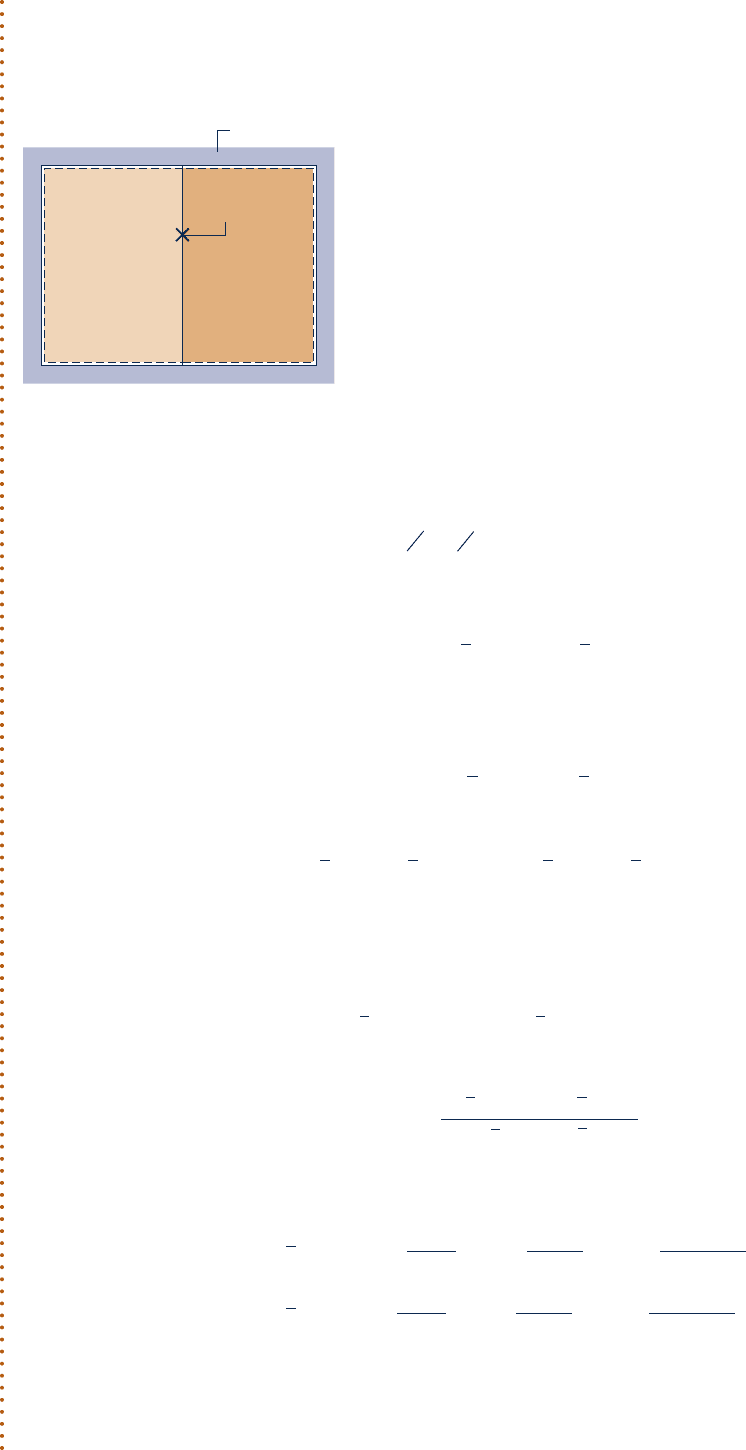
722 Chapter 12 Ideal Gas Mixture and Psychrometric Applications
Find: Determine the final temperature of the mixture, in 8R, the final pressure of the mixture, in atm, and the
amount of entropy produced in the mixing process, in Btu/8R.
Schematic and Given Data:
Valve
Initially 0.21 lbmol
of O
2
at 1 atm
and 540°R
Initially 0.79 lbmol
of N
2
at 2 atm
and 460°R
Insulation
Engineering Model:
1.
The system is taken to be the nitrogen and the oxygen together.
2. When separate, each of the gases behaves as an ideal gas.
3. The final mixture acts as an ideal gas and the Dalton model applies:
Each mixture component occupies the total volume and exhibits the
mixture temperature.
4. No heat or work interactions occur with the surroundings, and there
are no changes in kinetic and potential energy.
Fig. E12.5
Analysis:
(a)
The final temperature of the mixture can be determined from an energy balance. With assumption 4, the
closed system energy balance reduces to
¢U 5 Q
0
2 W
0
or
U
2
2 U
1
5 0
The initial internal energy of the system, U
1
, equals the sum of the internal energies of the two gases when
separate
U
1
5 n
N
2
u
N
2
1T
N
2
21 n
O
2
u
O
2
1T
O
2
2
where T
N
2
5 4608R is the initial temperature of the nitrogen and T
O
2
5 5408R is the initial temperature of the
oxygen. The final internal energy of the system, U
2
, equals the sum of the internal energies of the two gases
evaluated at the final mixture temperature T
2
U
2
5 n
N
2
u
N
2
1T
2
21 n
O
2
u
O
2
1T
2
2
Collecting the last three equations
n
N
2
3u
N
2
1T
2
22 u
N
2
1T
N
2
241 n
O
2
3u
O
2
1T
2
22 u
O
2
1T
O
2
245 0
The temperature T
2
can be determined using specific internal energy data from Table A-23E and an iterative
procedure like that employed in part (a) of Example 12.4. However, since the specific heats of N
2
and O
2
vary
little over the temperature interval from 460 to 5408R, the solution can be conducted accurately on the basis of
constant specific heats. Hence, the foregoing equation becomes
n
N
2
c
y, N
2
1T
2
2 T
N
2
21 n
O
2
c
y,O
2
1T
2
2 T
O
2
25 0
Solving for T
2
T
2
5
n
N
2
c
y, N
2
T
N
2
1 n
O
2
c
y, O
2
T
O
2
n
N
2
c
y, N
2
1 n
O
2
c
y, O
2
Selecting c
y
values for N
2
and O
2
from Table A-20E at the average of the initial temperatures of the gases,
5008R, and using the respective molecular weights to convert to a molar basis
c
y, N
2
5 a28.01
lb
lbmol
ba0.177
Btu
lb ? 8R
b5 4.96
Btu
lbmol ? 8R
c
y, O
2
5 a32.0
l
b
lbmol
ba0
.156
Btu
lb ? 8R
b5 4.99
Bt
u
lbmol ? 8R
c12IdealGasMixtureandPsychrometr722 Page 722 6/29/10 11:54:28 AM user-s146c12IdealGasMixtureandPsychrometr722 Page 722 6/29/10 11:54:28 AM user-s146 /Users/user-s146/Desktop/Merry_X-Mas/New/Users/user-s146/Desktop/Merry_X-Mas/New
